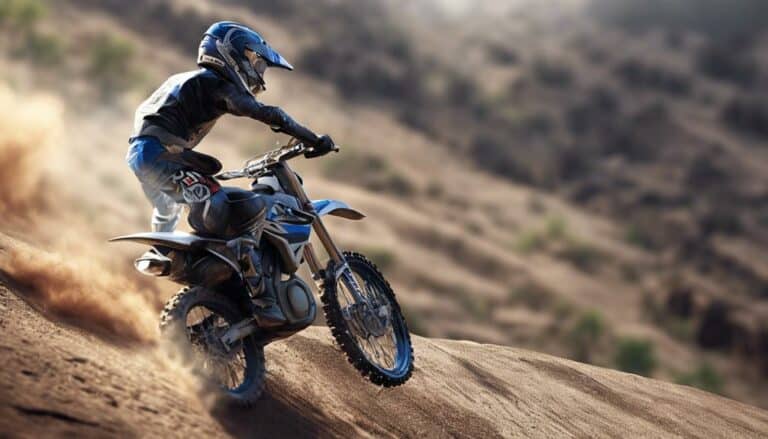Exploring diverse terrains on a dirt bike requires subtle adjustments in your body positioning to guarantee a smooth and controlled ride. From maintaining stability on flat ground to tackling the challenges of uphill, downhill, sandy, and rocky terrains, each setting demands a specific approach to keep you balanced and in command.
Understanding these variations in body positioning can greatly impact your performance and safety while riding, making it essential to master the art of adapting to different terrains on a dirt bike.
Key Takeaways
- Flat terrain requires centered body position for stability and control.
- Uphill terrain needs weight forward to prevent wheel spin and enhance stability.
- Downhill terrain demands weight shift back for balance and control.
- Adapt body position to sandy and rocky terrains for optimal traction and stability.
Flat Terrain Body Positioning
When riding on flat terrain with a dirt bike, position your body over the pivot point, ensuring your chin is directly above the handlebars and your elbows are bent upward and outward for best balance and control. By doing so, you effectively weight the front of the bike, optimizing your center of gravity for overall riding.
Distributing your weight evenly on both footpegs and maintaining a relaxed grip on the handlebars will enhance stability on flat terrain. Keeping your body centered and in a neutral position allows you to handle flat terrain efficiently on a dirt bike.
It's important to adjust your body positioning to keep your weight balanced and centered, enabling best control and maneuverability on flat surfaces. Remember, a well-maintained body position not only keeps the bike upright but also facilitates smooth navigation, making your overall riding experience more enjoyable and liberating.
Uphill Terrain Body Positioning
Adjust your body positioning when tackling uphill terrain on a dirt bike by shifting your weight forward to maintain traction and prevent tipping backward. Leaning your body slightly towards the front tire helps keep it grounded, allowing you to climb steep inclines more effectively.
By distributing your weight towards the front of the bike, you increase stability and control while traversing uphill sections. Uphill terrain demands a forward-leaning body position to counterbalance the incline and guarantee proper weight distribution for peak traction.
This strategic adjustment not only enhances rider control but also minimizes the risk of wheel spin, maximizing climbing efficiency on your dirt bike. Remember, mastering the art of positioning your body correctly on uphill terrain is key to conquering challenging slopes with confidence and skill.
Downhill Terrain Body Positioning
For best balance and stability on downhill terrain, lean back slightly while keeping your weight centered over the bike. By shifting your body weight back, you can prevent the front wheel from lifting and maintain control over the bike's momentum as you descend. Remember to bend your knees and elbows to absorb impacts and improve traction on steep slopes. Keep a relaxed grip on the handlebars, utilizing your legs for balance and shock absorption on rough downhill terrain. Adjusting your body position to lean back slightly will allow you to have better control and maneuverability on challenging downhill sections.
| Downhill Terrain Body Positioning | ||
|---|---|---|
| Technique | Description | Benefit |
| Lean back slightly | Keep weight centered over the bike | Control bike's momentum |
| Bend knees and elbows | Absorb impacts, maintain traction | Improve stability on steep slopes |
| Shift weight back | Prevent front wheel lift | Maintain control downhill |
| Relax grip, use legs | Balance, shock absorption | Stability on rough terrain |
Sandy Terrain Body Positioning
To maintain balance and traction in sandy terrain, shift your weight slightly back on the dirt bike. By doing so, you prevent the front wheel from digging in and losing control.
Keep the bike upright to avoid sinking into the soft sand and use your legs to absorb the bike's movements, helping it float over the challenging surface.
Utilizing your legs for balance and stability is vital in sandy terrain, enabling you to navigate the bike smoothly through the shifting sands.
It's essential to maintain a relaxed grip on the handlebars, allowing you to adapt quickly to the unpredictable nature of sandy terrain. Adjust your body positioning to compensate for the loose conditions, ensuring that you stay in control at all times.
Rocky Terrain Body Positioning
When tackling rocky terrain on a dirt bike, shift your weight towards the rear to maintain traction and keep the front wheel light. This adjustment helps the bike maneuver through rocky sections with more ease.
Standing on the footpegs is critical as it allows you to absorb impacts and lets the bike move freely over rocks. To optimize control on uneven terrain, lean slightly forward to increase traction and prevent the front wheel from slipping.
Your legs and arms should act as shock absorbers, helping you navigate rough patches smoothly. Mastering proper body positioning on rocky terrain is fundamental for enhancing stability, control, and overall riding experience.
Conclusion
To sum up, mastering body positioning on different terrains is like wielding a magic wand on your dirt bike. By shifting your weight with precision and finesse, you can conquer any landscape with ease.
So, keep practicing and refining your skills to become a dirt biking wizard on all types of terrain. Your journey to dirt biking mastery awaits, so grab your bike and let the adventure begin!

